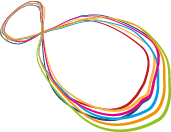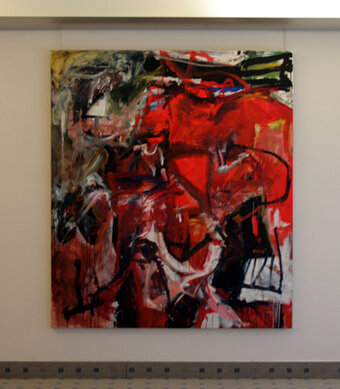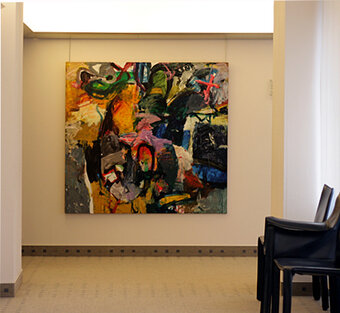Bert Jäger
January 26 to March 6, 2015 - The works cover the period from 1989 to 1996 - Painting and works on paperWhen visitors enter the attic floor, they are exposed to a frenzy of colors and shapes that they can hardly escape - and probably don't want to.
The large-format paintings (acrylic on canvas) unfold a coloristic splendor that you only want to differentiate after an extensive feast for the eyes in order to search for legible details.
In other words: What is depicted?
Cose della Vita, 1989 (left) - The things of life Lo stupore del grillo, 1989 (back left) - The amazement of the cricket Comizio dei funàmboli, 1989 (back right) - The rally of the tightrope walkers
The Italian titles refer to Jäger's studio in Pietrabruna in Liguria. The small community, which today has 540 inhabitants, is picturesquely situated high up in the mountains near Imperia above the Mediterranean. The title of this painting Lo sbarco dello scarabeo rinoceronte (The Exposure of the Rhinoceros Beetle) from 1989 was probably also created in this Mediterranean seclusion.
The title refers to the painting, but the subject of the painting does not illustrate the title, as it is left to our imagination to discover the story of the beetle in the color composition.
Something similar was probably also intended by the artist before the paintings Things of Life or The Amazement of the Cricket.
Perhaps the color points the way or at least gives the first clues to the picture behind the picture. The high-contrast and luminous, sometimes almost glowing composition is due to the intense play of light and color in the southern landscape. But not only that. Recovering from a serious eye disease - two operations were necessary in 1983 and 1984 - he found his way back to brush and paint. Now he passionately savored the new way of seeing.
The painting above, entitled Mäuseglück, was created in 1996 - two years before his death. Can you make out mouse traps in the painting, or the watchful eye of a cat in the center? Let's believe the title: the mice were lucky.

Details of the mouse's happiness reveal the force with which he applies the paint to the canvas without abandoning the given rhythm. The color forms interlock, as if they are there to stage a new play of colors.

The boundaries of the picture now seem arbitrary - it could go on and on, beyond the frame, and then even a huge wall surface would not be enough to accommodate the wildly advancing forms.




